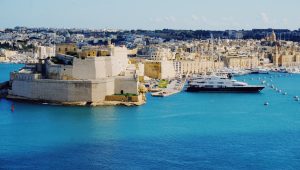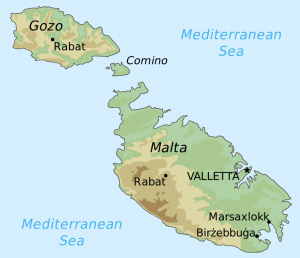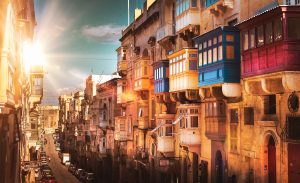59 Europe: Historical Geography II – Malta
Il-mistoqsija oht il-gherf – “A question is the sister of wisdom”
Maltese Proverb
Malta is a small island country, situated in the Mediterranean Sea, southwest of Italy and north of Libya. Its geographic location, natural harbors, and limestone quarries made it a strategic geopolitical prize historically, especially at two key military times. Coincidentally, these same features have drawn talent scouts from film and television, resulting, among others, in the hosting of a number of scenes from the popular series “Game of Thrones.”
In considering Malta, the acronym FOE is useful. Let’s start with the letter O. O is for old. As a pair of islands, the country Malta is only 122 square miles in area, about double the size of Washington, DC. The main island Malta is 95 square miles with the island Gozo being 26 square miles (Comino is one square mile, a nature preserve). As such, the country Malta is the tenth smallest country in the world. For comparison, Tahiti = 403 sq. miles, Great Abaco (unknown by most people, until Hurricane Dorian in 2019) = 442, Mauritius = 720, Puerto Rico = 3500.
Given Malta’s size, when might we expect that it would first be peopled? What about other small islands, in comparison? Tahiti’s first settlers, Polynesians, arrived about 1000 CE; however, that is the Pacific Ocean. Great Abaco 500-800 CE and Puerto Rico 2000 BCE, but in the Atlantic Ocean. Mauritius 1500 CE in the Indian Ocean. As it is with geography, location matters. Malta’s location in the Mediterranean Sea, allowed its discovery and settlement to come much earlier than these other modestly sized islands, for Malta sits in a much smaller sea and in the midst of many of history’s early seafarers.

Though Malta was not settled as early as much larger Mediterranean island such as Cyprus, Sicily, and Sardinia, this too makes geographic sense that these large islands would be discovered and utilized before tiny Malta. However, Malta has been settled since 5900 BCE. It has been considered a strategic location, controlled at times by Mediterranean groups including the Phoenicians, Romans, Arabs and later by European countries such as Great Britain and France. While these numerous peoples brought varied religions to the island, it is noteworthy that the apostle Paul, a major Christian figure, was shipwrecked on Malta around the year 60 CE. Although other points in history could have led to other religious patterns, Malta is now a largely Catholic country.

F is for Fortified. Limestone quarries abound on Malta; in fact, the islands Malta and Gozo essentially are slabs of limestone. As a relatively soft stone, limestone can be cut into blocks use as building materials. Although soft may sound weak for construction, actually limestone is prized for its strength, resistance to corrosion, durability, and non-slip and heat-resistant qualities. It is readily obvious to any visitor of Malta that nearly every human structure there is built of limestone. From ancient structures to modern urban residences, from cathedrals to fortifications, from coastal landscapes to burial catacombs, in Malta it is all limestone.

As more and more peoples came to Malta, more and more limestone was quarried. However, with human migration to Malta, there came conquests and dangers. The demand for simple shelter evolved into the need for fortified dwellings and urban areas. Thus, in the 8thcentury on Malta, limestone built the walled city now known as Mdina. At that time, it was the Phoenicians who developed this as the capital city, thus serving for nearly a thousand years. On Gozo, the walled Citadel was developed much later, beginning as a limestone castle in the 1500s.
Although there have been many peoples and many invaders arriving at Malta, two points in its military history stand out. First, in 1565 forces of the Ottoman Empire under the leadership of Suleiman the Magnificent sailed in nearly two hundred ships to Malta with a large invading force. Under siege and led by the Knights Hospitaller, Malta resisted the attack. According to the Knight order’s historian, the numbers clearly favored the Ottoman forces, who greatly valued Malta’s strategic location in Islam’s quest to gain more territory in Europe.
Malta vs. Ottoman Empire in 1565
| The Knights Hospitaller | The Ottomans |
|---|---|
| 500 Knights Hospitaller | 600 Spahis (cavalry) |
| 400 Spanish soldiers | 500 Spahis from Karamania |
| 800 Italian soldiers | 6000 Janissaries |
| 500 soldiers from the galleys (Spanish Empire) | 400 adventurers from Mytiline |
| 200 Greek and Sicilian soldiers | 2500 Spahis from Rumelia |
| 100 soldiers of Fort St. Elmo | 3500 adventurers from Rumelia |
| 100 servants of the knights | 4000 "religious" servants |
| 500 galley slaves | 6000 other volunteers |
| 3000 soldiers from the Maltese population | various corsairs from Tripoli and Algiers |
| Total: 6100 | Total: 28500 from the East, 40000 in all |
Although Ottoman forces earlier had taken Gozo and while Suleiman had won numerous battles elsewhere to expand the Ottoman Empire, the nearly four-month siege of Malta was unsuccessful for the invaders. The invasion though repelled by Maltese forces prompted additional use of limestone, as the new port city Valletta was founded in 1566, featuring towering limestone fortified walls.
The siege proved to be a singular turning point in the history of Malta, securing a strategic location in the defense of Europe. Malta’s cultural, economic, and military foci then never strayed from Europe, eventually extending to Malta’s entrance into the European Union in 2004 and the Eurozone in 2008. Additionally, the role of knights, prominent in Europe, gained prominence in Malta, with Europe’s Knights of St. John (the Order of Knights of the Hospital of Saint John of Jerusalem or the Knights Hospitaller) being headquartered there from 1530 to 1798.
Europe’s hold on Malta continued, but altered course with Napoleonic takeover of Malta in 1798, only to be quickly supplanted by British rule, starting in 1800. Malta remained a British colony until independence in 1964 with subsequent conversion to a republic in 1974.

The second key point in Malta’s military history was World War II. As a British colony, obviously, Malta fought on the side of the Allies. This siege, 1940-1942, of course involved attacks by air as well as by sea. German and Italian aircraft bombed Malta repeatedly, as Allied forces sought to withstand and to repel the attackers. Winston Churchill likened Malta to “an unsinkable aircraft carrier.” Malta’s strategic value was at its highest during the war’s campaigns in North Africa. Overall, in three years of attacks, Malta’s military and civilians were put on alert over 3000 times. In fact, Maltese and Allied forces withstood the siege and defended Malta successfully. Malta’s usefulness as a base for navy and air force was important for the overall Allied victory in the war. British King George awarded the Maltese people in general the George Cross as a recognition of heroism. This George Cross became part of Malta’s national flag.

E is for European. As a result of Malta’s victory over Ottoman invaders in 1565, Malta’s regional focus remained centered on Europe and did not turn toward the Muslim world. Subsequent rule by French and then British before eventually independence held that European perspective. One aspect of European culture in Malta is seen in language. Although the native language is Maltese, almost everyone can speak English. Two-thirds of the population can speak Italian and one-sixth French. Maltese language itself is a curious mix that reflects the island’s geographic position. Maltese is a Semitic language in the same family as Arabic, but a majority of its words have Latin derivations and it uses a modified Latin alphabet. Of the top ten countries sending tourists to Malta, the United Kingdom is number one, while the USA at number nine is the only non-European country in the top ten. Britain’s influence is seen in a variety of ways, including driving on the left side of the road.
FOE. Fortified Old European. Malta.
DId You Know?
The famous rock arch on Gozo known as the Azure Window collapsed in 2017 during a big storm.
The local soft drink is Kinnie, a bitter orange soda.

On Malta, the walled city Mdina takes its name from the Arabic word “medina” which means “city.” This is a reminder that Arabs were one of many groups to live on the island.
Cited and additional bibliography:
Balbi di Correggio, Francesco. 1965. The Siege of Malta 1565. Translated by Ernle Bradford. London: The Folio Society.
Bjankuloski06en. 2013. Physical Map of Malta. https://en.wikipedia.org/wiki/Malta#/media/File:General_map_of_Malta.svg. Creative Commons Attribution-Share Alike 3.0 Unported.
“Malta – Wikitravel.” 2016. Wikitravel.Org. 2016. https://wikitravel.org/en/Malta.
McGinty, James. 2020. “Malta.” College of DuPage. College of DuPage GIS class. Instructor Joseph Adduci.


